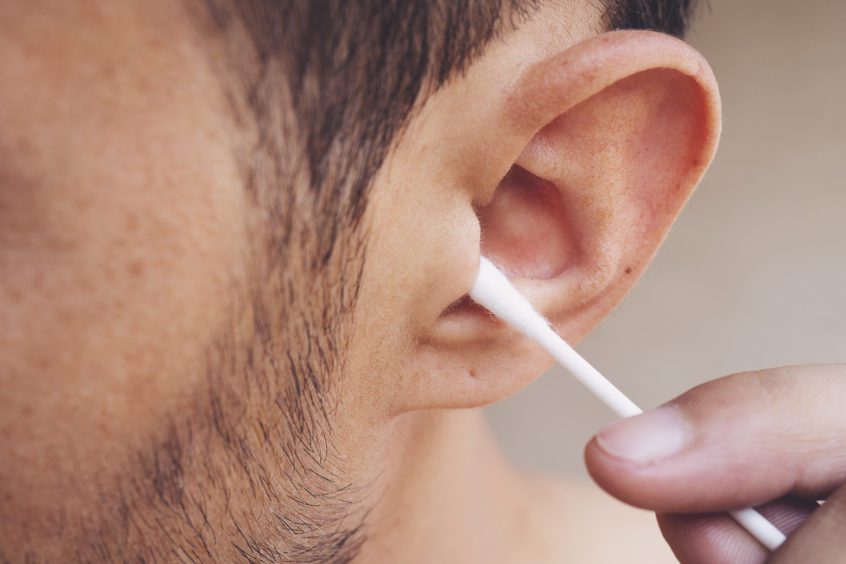How Earwax Buildup Can Impact Your Hearing
If you’re like millions of Baby Boomers, you grew up with this staple on the bathroom counter—cotton swabs. Parents used them to clean your ears as an infant, and as you grew older, taught you that’s the best way to keep your ears clean, too. But is it? Cotton swabs may not be just what the doctor ordered.
The first mass-produced cotton swab was developed in 1923 by Polish-American Leo Gerstenzang after he watched his wife attach wads of cotton to toothpicks to clean their infant’s ears. Recognizing that probably wasn’t a good idea, he developed cotton swabs, and eventually, that product became known as Q-tips, going on to become the most widely sold brand name of cotton swab in North America.
Cotton swabs can be okay to use when cleaning the outside of the ear, but when it comes to swabbing the inside of the ear, they can actually push earwax down into the ear canal. And if you have a lot of earwax, that can create a problem called impaction, which is a legitimate issue that may cause hearing difficulties, tinnitus and dizziness.
Everyone has earwax, better known in the medical world as cerumen. In fact, earwax serves an important purpose. The glands inside your ear canals secrete the substance, and it looks different for different individuals. For most, it’s yellowish or honey-colored, or sometimes grayish, and it can be sticky or dry.
Its job is to protect your outer ear and ear canal, trapping dust and dirt, and keeping debris from traveling down your ear canal. It also can stop unhealthy bacteria from growing in the ear.
Unfortunately, you can have too much of a good thing—some people’s bodies just produce more earwax than others. Plus, some medications, exercise or stress can cause your body to make more earwax. Your body also produces more earwax as you get older, and some individuals who wear hearing aids may produce more earwax.
How to Remove Earwax Naturally
Though we may think we have to “swab” earwax out of our ears, it often works its way out by itself. Earwax is constantly being transported out of the ear canal to the ear opening. Chewing and jaw motion assist with this natural cleaning process. Once the wax reaches the outer ear, it dries, flakes, and falls out.
But several generations have been taught keeping our ears clean requires some extra help in the form of cotton swabs. Audiologists agree using cotton swabs to clean the ear canal is not a good idea. They can push the wax deeper into the ear canal, rather than removing it. Instead follow these tips:
- Use a warm, moist wash cloth to clean the outside of your ears.
- NEVER put anything in the ear canal, especially sharp objects, like toothpicks or hair pins. Not only can you push the ear wax further into the canal, but you could potentially puncture the eardrum.
- NEVER use ear candles or “candling” to try to remove earwax. The Food and Drug Administration has issued safety warnings regarding this home remedy and it could result in a serious injury.
- Many of the “as seen on TV” options for wax removal are not recommended and in some cases are not safe. Avoid these.
When a Washcloth Doesn’t Work
Sometimes, a washcloth doesn’t work to get the wax out of your ears, but more difficult-to-remove earwax usually responds to home treatments that soften wax. For example, you can try placing a few drops of mineral oil, baby oil, glycerin, or commercial drops in the ear. Detergent drops such as hydrogen peroxide or carbamide peroxide (available in most pharmacies) may also help remove earwax. Some of these remedies can inadvertently irritate the sensitive skin of the ear canal.
Though it’s not common, if you have impacted ear wax that’s close to your eardrum, it could affect your hearing and cause temporary hearing loss or dizziness. Audiologists and doctors call this impacted earwax. Here’s how to tell if you have impacted earwax:
- Earache
- Feeling of plugged hearing or fullness in the ear
- Partial hearing loss that gets worse
- Tinnitus, ringing, or noises in the ear
- Itching, odor, or discharge
- Coughing
- Pain
- Infection
If you have any of the symptoms above, check with your audiologist or doctor to see if you might have excess or impacted earwax.
If you do, an audiologist or another medical professional might need to inspect your ear canals and if necessary, may either remove the earwax by washing it out, or by manually removing it using suction or special miniature instruments under lighted magnification.
Manual wax removal is preferred if your ear canal is narrow, the eardrum has a perforation or tube, other methods have failed, or if you have skin problems affecting the ear canal, diabetes or a weakened immune system.
Remember, never put any objects, even cotton swabs, in your ears. You risk pushing the wax down your ear canal and could even perforate the eardrum, a problem that might require surgery.
If you are prone to repeated wax impaction or use hearing aids, consider seeing your audiologist every six to 12 months for a check-up and routine preventive cleaning. In addition, audiologists carry special products and over-the-counter solutions for cerumen management that are safe and specific for self use.
If you have ear pain, drainage or bleeding, see your audiologist or physician immediately. These are not symptoms of earwax impaction, and should be checked by a healthcare professional.



